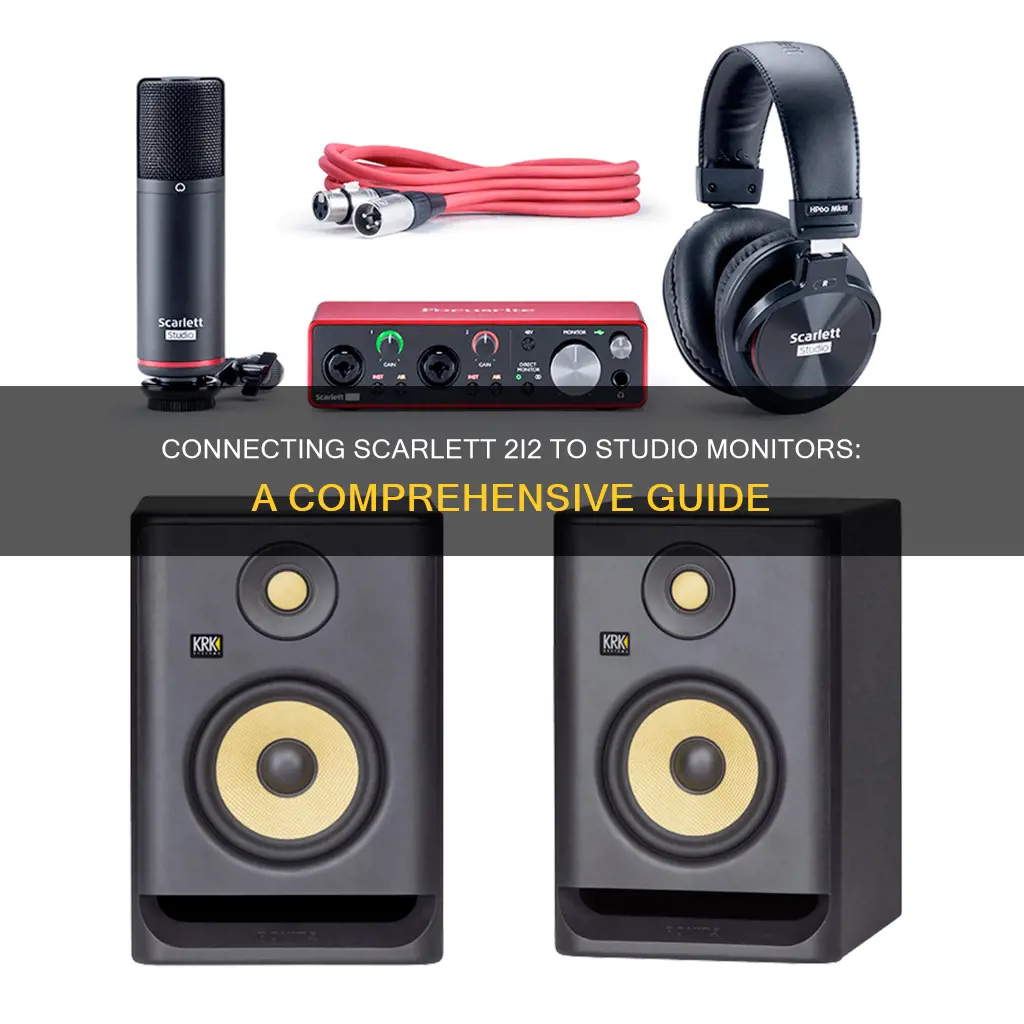
If you want to connect your Scarlett 2i2 audio interface to studio monitors, there are four methods you can use, depending on the type of inputs your studio monitors have. The four methods are:
1. Using balanced 1/4 TRS cables
2. Using balanced 1/4 TRS to XLR cables
3. Using unbalanced 1/4 TS cables
4. Using unbalanced 1/4 TS to RCA cables
| Characteristics | Values |
|---|---|
| Recommended cables | Balanced 1/4″ TRS cables, Balanced 1/4″ TRS to XLR cable, Unbalanced 1/4″ TS cable, Unbalanced 1/4″ TS to RCA cable |
| Cable features | Balanced cables offer better sound quality and facilitate longer cable runs; unbalanced cables are more prone to interference and noise |
| Cable identification | Balanced cables have two rings, unbalanced cables have one ring |
What You'll Learn

Balanced 1/4 TRS cables are the best option
If you're looking to connect your Scarlett 2i2 audio interface to studio monitors, you'll want to use balanced 1/4" TRS cables. This is the simplest and most effective method, offering the best sound quality and the flexibility of longer cable runs if needed.
Balanced 1/4" TRS cables are the best option for connecting your Scarlett 2i2 to studio monitors because they provide a balanced connection. This means that they send two versions of the audio signal: one normal and one phase-inverted. By comparing these signals at the receiving end, any noise or interference is prevented, resulting in a clearer audio output.
Additionally, balanced cables are less susceptible to external factors such as audio, magnetic, and electrical interference. This ensures that you get the best possible sound quality from your studio monitors. The connection process is straightforward, and these cables are widely available. Just remember to match the left and right outputs on your Scarlett 2i2 with the corresponding inputs on your studio monitors.
While you could also use unbalanced 1/4" TS cables, they are more prone to interference and noise. This could result in buzzing or humming noises in your audio setup. So, if you're looking for the optimal connection method, balanced 1/4" TRS cables are the way to go.
In summary, when connecting your Scarlett 2i2 to studio monitors, balanced 1/4" TRS cables are the recommended choice. They offer superior sound quality, noise rejection, and the convenience of longer cable runs. By understanding the difference between balanced and unbalanced connections, you can make an informed decision and get the most out of your studio equipment.
Identifying Your ASUS Monitor: A Step-by-Step Guide
You may want to see also

Balanced 1/4 TRS to XLR cables also work well
Balanced 1/4" TRS to XLR cables are a great option for connecting your Scarlett 2i2 to studio monitors. This setup offers the same quality and efficiency as a balanced TRS cable connection. XLR connectors can be more convenient to work with and are a good choice if you need longer cable runs, as XLR extension cables can easily be added.
Balanced cables are the recommended option for connecting audio equipment, as they offer better sound quality and are less prone to interference and noise compared to unbalanced cables. Balanced cables have two rings, which send two versions of the audio signal (one normal and one phase-inverted). This allows the receiving end to compare the signals and cancel out any noise.
When using balanced 1/4" TRS to XLR cables, you will connect the Scarlett 2i2 1/4" outputs to the XLR cables, and then connect the XLR cables to the speaker XLR inputs. This setup is straightforward and effective, providing clear audio transmission.
It's important to ensure that you match the left and right outputs on the Scarlett 2i2 with the corresponding speaker inputs to maintain proper stereo imaging. Additionally, using balanced cables can help facilitate longer cable runs if needed, making this setup flexible and suitable for various studio configurations.
Asus Monitors: Do They Track Usage Hours?
You may want to see also

Unbalanced 1/4 TS cables will work for most
To connect your Scarlett 2i2 audio interface to studio monitors, you have a few options, including using unbalanced 1/4" TS cables. This is a straightforward method that will work for most setups.
Firstly, let's understand the difference between balanced and unbalanced connections. Balanced connections, like the ones established using TRS cables, offer better sound quality and are less prone to interference. Unbalanced connections, on the other hand, are more susceptible to noise from audio, magnetic, and electrical interference.
Now, when it comes to using unbalanced 1/4" TS cables with your Scarlett 2i2, here's what you need to do. You will connect the Scarlett 2i2 1/4" outputs to the unbalanced 1/4" TS cables, and then connect the other end of the cables to the speaker 1/4" inputs. This setup will work for most people connecting the Scarlett 2i2 to studio monitors.
However, it's important to note that with unbalanced connections, you may experience buzzing or humming noises. If this happens, it's recommended to upgrade to balanced cables, such as the balanced 1/4" TRS cables mentioned in Method 1, or the balanced 1/4" TRS to XLR cables in Method 2.
Additionally, when using any of these methods, ensure that you correctly match the left and right outputs to the corresponding speaker inputs.
Asus VE278: Webcam Ready LCD Monitor?
You may want to see also

Unbalanced 1/4 TS to RCA cables are an option
Unbalanced 1/4" TS to RCA cables are an option to connect your Scarlett 2i2 to studio monitors, but this method is not recommended unless there are no other alternatives. RCA connections are considered antiquated, and you will likely experience interference and noise.
If your studio monitors feature RCA inputs, you will need a cable with 2 x TS jacks at one end and 2 x RCA jacks at the other. Some studio monitors have two RCA inputs on one speaker, with a cable wire passing a signal to the second speaker. Others have a single input on each speaker, requiring you to split the RCA end of the cable.
While this method is simple to set up, it is important to note that unbalanced connections are more susceptible to audio, magnetic, and electrical interference. This can result in buzzing or humming noises. If you encounter these issues, you may need to upgrade to balanced cables.
Balanced connections, such as those provided by 1/4" TRS cables or XLR cables, offer better sound quality and facilitate longer cable runs. They are the recommended option for connecting your Scarlett 2i2 to studio monitors.
Monitoring Bandwidth Usage: SolarWinds Simplified Guide
You may want to see also

RCA inputs are antiquated but still work
RCA inputs are considered antiquated now, but they still work. If your studio monitor only has RCA inputs, you'll need to use an unbalanced connection. This setup is simple to configure, but you'll require a cable with two TS jacks on one end and two RCA jacks on the other.
Some studio monitors have two RCA inputs on one speaker, with a cable wire passing a signal to the second speaker. Others have a single input on each speaker, requiring you to split the RCA end of the cable.
While this method will work, it is not recommended if you have other options. Balanced connections, such as those provided by XLR or TRS cables, offer better sound quality and are less prone to interference and noise.
If you are using RCA inputs, make sure to match the left and right outputs on the Scarlett 2i2 with the corresponding inputs on the studio monitors. The left and right channels on the monitors should be clearly marked.
Additionally, ensure that you have the correct power supply for your monitors. Each monitor typically requires its own power cable.
Asus vs Acer: Which Monitor Brand is Superior?
You may want to see also
Frequently asked questions
You will need two male-to-male TRS cables or male-male TRS-XLR cables.
The simplest way to connect Scarlett 2i2 to studio monitors is by using balanced 1/4" TRS cables.
Balanced cables have two rings and send two versions of the audio signal, allowing them to compare the signals and prevent noise. Unbalanced cables have one ring and are susceptible to noise from audio, magnetic, and electrical interference.
If your studio monitors only have RCA inputs, you will need an unbalanced 1/4" TS to RCA cable.
Yes, you can connect Scarlett 2i2 directly to studio monitors if they are self-powered or active monitors. If you have passive speakers, you will need a separate amplifier.







